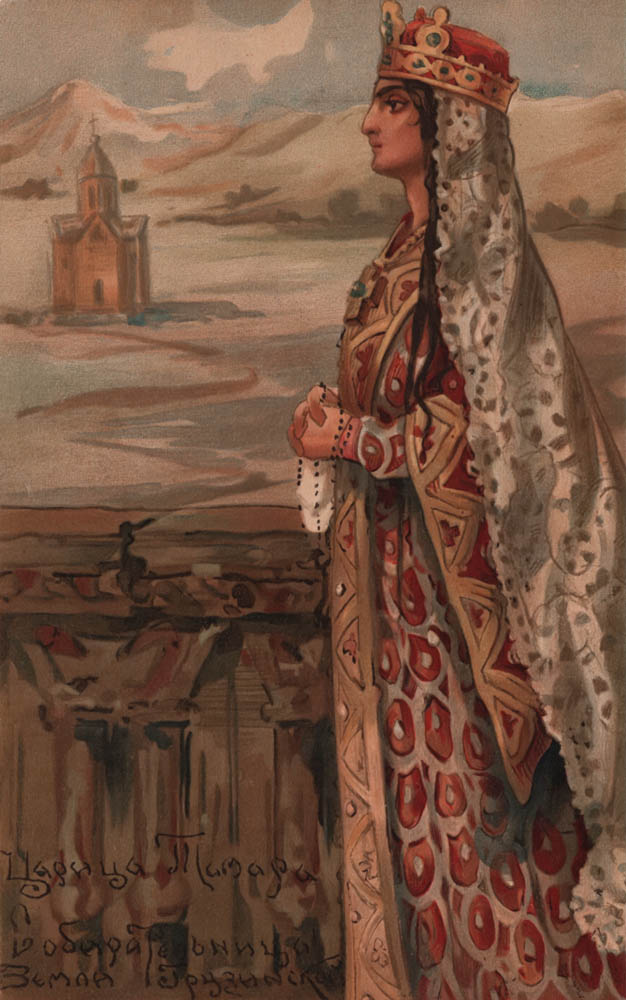The exact date of Queen Tamar’s birth is unknown, although historians propose the year 1165. Her mother died when the future queen was still young, and Tamar was raised by her aunt Rusudan, who provided Tamar with excellent education. Tamar was not yet two when her father, King George III sensed his approaching death and made Tamar queen. For the first time in its history, Georgia’s throne was given to a woman. Her father died shortly after, and the young girl had to rule independently. She did so boldly and justly, earning the admiration of her people. News of the young queen spread across the neighbouring states. It was said that of “royally casting her eyes around, had a pleasant tongue, speech that delighted the ear, was cheerful, and in conversation was free from any looseness or vice.” Legends were composed about her perfection: Tamar’s hand was sought after by Byzantine princes, the Syrian sultan and the Persian shah. The young queen, however agreed to marry Yury Bogolyubsky, son of Prince Andrew Bogolyubsky, which she did in 1188. The union was motivated only by political considerations, for Tamar had no feelings for her berothed. The relations between the newlyweds soon broke down: occasionally Yuri even struck his young wife.
After enduring her husband’s drunkedness and debauchery for two years, Tamar forced Yuri to leave Georgia. The angered prince headed to Constantinople to gather a large army and wage war on his offender. Yuri promptly lost and forced to return to his homeland in disgrace. Georgia, in the meantime continued to flourish, and soon became one of the wealthiest states of its time. Legends were composed about its ruler, extolling her beauty, generosity and wisdom. Tamar built fortresses, roads, ships and schools. The queen invited the best scholars, poets, philosophers, historians, and theologians to Georgia. Thus, she met Shota Rustaveli. The poet was born in Rustavi and initially studied in Georgia’s monasteries, before continuing his education in Athens. Shota became Tamar’s treasurer. His epic poem “The Knight in the Panther’s Skin” became one of the finest examples of medieval literature. In it, Shota celebrated the ideals of love, friendship, nobility, honor, and virtue – all the qualities he so admired in his ruler. The poet described Tamar thus:
The pearls of her rosy lips,
under the ruby canopy
Even stone breaks with a soft leaden hammer!
The tresses of the queen are agates,
brighter than the glow of rubies.
One who beholds the sun delights in nectar.
Soon the time came for Tamar to think about sucession. She decided to marry a man she knew and trusted since childhood – the Ossetian prince Soslan. Brave, noble and devoted to his wife, her second husband finally brought Tamar the long-awaited happines. A year after they married, Tamar gave birth to a son, whom the couple named George. A year later, the couple’s second child – a girl whom they named Rusudan – was born. Tamar died on January 18th 1212 from a severe illness. She was buried in the family crypt in Gelati. Centuries later,the tomb was opened, but nothing was found there. According to legend, during her last days, Tamar asked for her place of burial to be kept secret, lest it be found and desecrated by the Muslims, who could not defeat the queen despite a protracted struggle. In secret, Tamar’s ashes were taken from the monastery where they lay – their current resting place is unknown. According to records found in the Vatican, Tamar was buried in the ancient Georgian monastery of the Holy Cross, in today’s Palestine. All her life she wanted to visit it, but could not do so due to numerous wars. Accordingly, she requested to be laid there in death. Queen Tamar is now a saint.
